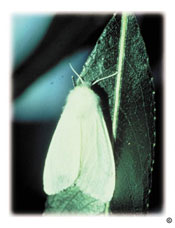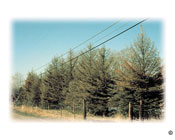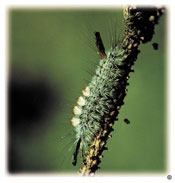
The Douglas-fir tussock moth is a major pest of Douglas fir, spruce and other conifers in Colorado. Larvae of the tussock moth can completely defoliate trees in forests, and it’s also a major pest in urban areas. Damage usually starts first at the tops of trees and moves downward. Top kill of trees can occur in urban infestations, but the entire tree can die if the
insect isn’t controlled.
Tussock moth caterpillars are black and have very long body hairs. As a caterpillar grows larger, its body becomes ornamented with brightly colored tufts of hair. Two prominent, long tufts of black hair project forward from the head. A similar tuft projects back from the rear of the body. The hairs are irritating if touched. An orange stripe also can be seen on each side of the caterpillar’s body. 
Adult moths are relatively bland in appearance. Females have small wings and can’t fly. Egg masses are covered with a frothy substance intermixed with larval hairs. Eggs hatch in late May or early June.
The Douglas-fir tussock moth has a number of natural enemies including insect parasites and predators, birds and disease organisms.  Pesticides registered for use against tussock moth include Sevin, many pyrethroids and spinosad.
Pesticides registered for use against tussock moth include Sevin, many pyrethroids and spinosad.
For more information, see the following Colorado State University Extension fact sheet(s).



